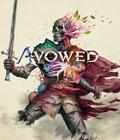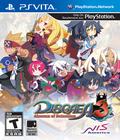Nippon Ichi Software has a strange way of handling its Disgaea franchise. When a new game in the series is created, it hits a home console first. That has been the PlayStation 2 for the first two games and PlayStation 3 for the last two games. A few years later, the game is ported with a few extra features, essentially making them director's cut versions. The first game gained a multiplayer mode as well as an alternate story line while the second game added more characters to download and had an alternate plot but ripped away the multiplayer. Following in those footsteps, NIS America decided that the PS Vita needed a new Disgaea in the form of Disgaea 3: Absence of Detention, an enhanced port of the first PS3 title in the series.
After taking a nobler detour with the second game, the plot for the third game features evil intentions and hilarity. You play the role of Mao, son of the Evil Academy's Overlord and top honor student — because he's never attended a class. After his father accidentally destroys his game console and save files, he wants to capture a hero so he can become one and overthrow his dad. Meanwhile, Mao's childhood rival, Raspberyl, a delinquent who does all of her homework and attends all classes, hears about the plan and tries to stop Mao in order to protect her top delinquent status.
Disgaea was always meant to be a funny game, and plot aside, this is no different. The items and weapons offer some laughs due to their absurd names and descriptions. The characters are often played up for laughs, but they do so in a way that doesn't make you sick of them. Likewise, the dialogue is funny but isn't overdone to the point where it feels forced. Those who wonder whether the humorous translations have gone stale over the years should be satisfied with the results.
Like its predecessors, Disgaea 3 follows a pretty basic strategy RPG formula. The fights take place in areas divided by square grids, and the goal is to wipe out the enemy forces before you run out of soldiers. Your troops always come out of a central spot, and your attacks, which vary in damage depending on your position against the enemy, are turn-based, so you execute all of your moves before the enemy gets to do the same.
Unique to the Disgaea world is the idea of placing up to four characters next to each other to initiate super attacks against one person. The idea of throwing something — or someone — to reach higher elevations or as an attack is also viable and hilarious. Geo tiles make their return; any character stepping on them gets augmented abilities in either positive or negative ways. Likewise, geo blocks can be used as platforms to augment your abilities or to destroy geo tiles in your path. At the end of each fight, you'll be able to earn bonus equipment and cash, depending on how well you fought.
While the fighting rewards those who are crafty, the depth comes from the exploration of the school hub between battles. Healing stations charge for their services, and as you use them more often, you increase the chances of getting bonus items. Likewise, spending money at shops gives you the chance to get discounts later, and every visit produces a different inventory and different costs. Classrooms serve as places where you can arrange your army to increase combo chances, and you can also create new characters and classes here. As expected, lower-tier characters are usually free while higher-tier ones need approval from your classmates, though you can usually buy votes. You can also petition to get more expensive items or cheaper ones sent to the shops, so you'll no longer need to hope that you'll stumble upon something useful.
The traditional grinding offered by other RPGs has been offset by the spending of mana points to get new abilities and battles to boost weapon attributes. It's still a form of grinding, but it at least feels different. New to this game is the ability for monsters to be transformed into powerful weapons; while an exploding Prinny may be fine as a live bomb, he is much more useful if he's transformed into a laser gun.
As expected, the Vita version of the game sports some extras over its home console iteration. For starters, all of the DLC from the PS3 version makes its way here, and considering how much content that it entails, the importance of that addition can't be underestimated. Two characters from Disgaea 4 make their appearance here as boss fights, giving you even more missions. The battle system has received a few tweaks. The specialty skills that were previously only available to story-specific characters can now be obtained by every member in your party. Both you and the enemy can unleash super moves when that member's health drops below a certain point, and special attacks can be used to continue a combo instead of ending it. There's also the ability to customize the appearance of your favorite weapon or item, though that'll only be appealing to those who care about aesthetics over anything else.
There are a few Vita-specific additions that do not feel very useful. The Data Shop lets you look at a leaderboard to see everyone's progress, character leveling and time spent in the game. Considering that strategy RPGs aren't played competitively, this inclusion is odd. Also, the game makes use of the system's Near program by giving you bonus Honor Quotient points if you play in different locations. The points gained via this method are rather small, though, and considering that honor points can be earned faster by playing the game and winning battles, it feels like a feature very few will notice.
Aside from the humor, the game has been praised by fans for its dedication to the hardcore strategy enthusiast. This version continues that tradition. On average, the core game will take you around 30 hours to complete through decent leveling. However, the matter of powering up your weapons to ridiculous levels gives you a wealth of grinding opportunities that somehow don't feel tedious. Those weapon missions also give you an opportunity to level your characters to an unfathomable 9999, and while that's more than enough to beat the game, enthusiasts will relish the opportunity to replay missions and partake in as many side-quests as possible to reach that lofty goal.
However, Disgaea 3 also carries over some of the bothersome traits from the older titles. From the gameplay side, the monster transformation remains the only new game mechanic. Aside from the tweaks, you're getting nothing new, as the game flow remains the same as it did in past titles. Granted, your hub world does everything you need, but a little change in inhabitants and decor would've been nice. From a technical standpoint, the camera system still remains problematic. Rotation is only set to four fixed angles, which would be fine if some objects weren't transparent, making it difficult to see which tile is highlighted. With these things noted as issues long ago, it is disheartening to see that they still haven't been addressed.
The controls for a strategy RPG are never really complicated, and this game doesn't buck that trend. The buttons are responsive enough, though the increased sensitivity of the analog sticks means you'll likely stick with the d-pad for cursor movement. Like most of the other games on the system, there are some halfhearted Vita-specific controls. The touch-screen is good for controlling camera elevation, but you're only switching between three static viewpoints. The touch-screen is also good for scrolling through menu screens but not for menu selection or character movement. The rear touchpad is also put to use as an alternative to menu scrolling and camera rotation, and the screen informs you when you're tapping on the appropriate part of the pad that initiates the function. For those who find it cumbersome, the developers have thrown in the option to turn it off — a rare find this early in the system's lifecycle.
On the PS3, Disgaea 3 was criticized for not taking advantage of the system's graphical power. Most people stated that it looked like the PS2 game with smoother polygon assets and smoothed-out sprites. That accusation can also apply to the PS Vita version. The polygonal floors are smooth with nary a jagged edge in sight, and the textures are crisp. Meanwhile, the other environmental elements don't come through with the same clarity and appear blurred. Other environments have simple backgrounds that aren't much to look at when you aren't dishing out commands. The characters are still made of sprites, but the look isn't as sharp as expected. Depending on the selected options, the characters can look blurry or sharp. The animations haven't changed, either, so the lack of a jumping animation and stilted running are all present. The only real change is the addition of animations in the cut scenes. Those looking for a big graphical upgrade from the PSP version will find this to be underwhelming, especially if you're playing those earlier PSP games on the Vita.
The sound is exactly the same as the PS3 iteration, so it does well in some parts and misses the mark in others. The voices are done in both Japanese and English, and while purists will likely go with the Japanese track, the English track is done pretty well thanks to good casting and excellent line delivery. The sound effects appear unchanged from earlier incarnations, but at least they're not muffled. The music, however, just doesn't reach the heights of the earlier games. Featuring a soundtrack that's more joyous than evil, it highlights the cheerful nature of the game and makes the demonic elements feel out of place. It is also tiresome in places. For example, the theme song plays anytime you're in the main academy grounds. Considering how many times you'll go to this area, you'll quickly tune out the melody.
Disgaea 3: Absence of Detention for the PS Vita falls in the same category as the earlier iterations for the PSP in that they're much better than their console counterparts, though not by an overwhelming amount. The inclusion of the console DLC makes up for the wait while the exclusive content and features are hit-and-miss. Even though it only looks slightly better than its PSP counterparts, the game is still fun, and the core game will keep strategy RPG fans busy for a long, long time. For those who've already gone through the PS3 incarnation, there isn't enough of a reason to get this one unless you never invested in the DLC. For everyone else who are fans of the genre, this is a worthy enough purchase.
Score: 7.5/10
More articles about Disgaea 3: Absence of Justice












 Disgaea 3 is a rich and deep Strategic RPG that's not afraid to display a very bizarre sense of humor. It's a combination that will leave you laughing one minute and fighting enemies the next.
Disgaea 3 is a rich and deep Strategic RPG that's not afraid to display a very bizarre sense of humor. It's a combination that will leave you laughing one minute and fighting enemies the next.








































